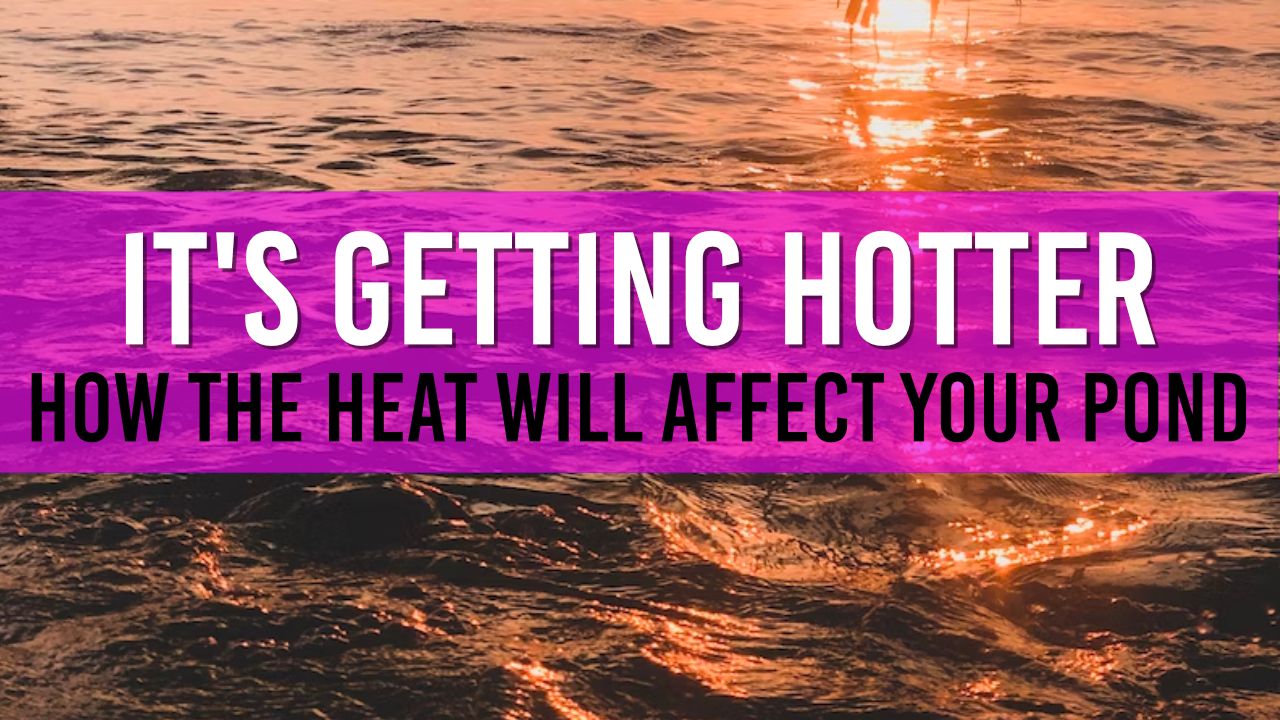Hot Weather and Thunderstorms and how they affect Your Pond
Hot weather can raise pond temperatures and reduce oxygen levels, affecting fish health. Thunderstorms may alter water chemistry, causing stress for aquatic life. Mitigate effects through shade, water changes, aeration, and regular water quality checks.

Table of Contents
Having a pond in your garden is a delight. It attracts wildlife, enhances your property's aesthetic, and provides an oasis of calm and tranquility. But, as a pond owner, there are a variety of weather-related challenges that you have to contend with. Two of the most significant are hot weather and thunderstorms. These can have a profound impact on your pond's health and the wellbeing of its inhabitants.
Hot Weather and Your Pond
Hot weather can cause a series of challenges for your pond. The first thing you may notice during a heatwave is an increase in algal blooms. The heat fuels the growth of algae, turning your clear, clean pond into a murky mess. It's important to note that not all algae are harmful, but overgrowth can cause problems like green water, unpleasant odors, and even deplete oxygen levels which may harm your fish.
To manage hot weather, you need to ensure that your pond is well oxygenated. This will not only help keep algae under control, but it will also ensure that your fish have plenty of oxygen to breathe. You can add more oxygen to your pond in a few ways such as installing a fountain or an air pump. Furthermore, a well-chosen pond pump can greatly assist in maintaining the water circulation, which in turn helps oxygenate the water.
Hot weather also accelerates the decay of organic material in your pond. This could be fallen leaves, dead insects, or fish waste. This is why it's essential to remove leaves from your pond regularly and remove old food that your fish haven't eaten. The decay process can use up the oxygen in the water and produce harmful byproducts, putting your fish at risk.
Fish Behaviour in Hot Weather
Fish are ectothermic animals, meaning their body temperature fluctuates with the surrounding environment. Consequently, they can become more active in warmer temperatures. However, if the temperature becomes too high, it can be harmful, and you may notice your fish gasping for air. This is a sign that the oxygen level in the water is too low.
To keep your fish healthy, monitor their behavior closely in hot weather, and ensure they're being fed properly. If they're not eating, it may be a sign of stress or illness. You can find more about why your pond fish may not be eating and what type of food to buy on our website.
Thunderstorms and Your Pond
Thunderstorms bring rain, and lots of it. This can cause your pond to overflow, which can wash away plants and erode the banks. It's important to have a well-designed pond with proper overflow measures to prevent these issues.
Rainwater can also cause problems with the water quality. It can change the pH level, introduce pollutants and nutrients that can lead to increased algae growth. If you're in an area with acid rain, it could even harm your fish. Therefore, it might be a good idea to use rainwater cautiously.
Thunderstorms can also cause power outages. This can affect the operation of your pond pump and other equipment such as your UV filter. Without these running, the water can quickly become stagnant, and oxygen levels can drop. You can consider a solar-powered pond pump as a backup option.
Pond Fish During Thunderstorms
One of the main concerns during a thunderstorm is how it affects your pond fish. There are a few misconceptions about thunderstorms hurting pond fish. The truth is, fish are usually not affected by the thunder and lightning itself, but abrupt changes in water conditions can be harmful.
After a thunderstorm, check your pond's pH level and temperature to ensure they're within the acceptable range for your fish. You should also inspect the pond for any debris or damage caused by the storm.
In summary, weather conditions like hot weather and thunderstorms can significantly impact your pond's health and the wellbeing of your fish. But with careful planning, regular maintenance, and the right equipment, you can ensure your pond thrives in all weather conditions.
Helping Your Fish in Hot Weather
Hot weather can be tough on fish in your pond, but there are a few steps you can take to make it easier for them. From adding fresh water to installing a bubble machine, here are a few tips that can help your fish stay healthy and comfortable during the sweltering summer months.
Adding Fresh Water
Adding fresh water is a simple yet effective way to help keep the temperature in your pond from becoming too high. But remember, it's crucial not to suddenly add large amounts of cold water as this can cause a shock to your fish due to a rapid change in temperature. Instead, regularly add smaller amounts of fresh water to gradually reduce the water temperature.
However, be careful when using tap water. It often contains chlorine, which can be harmful to fish. Make sure to use a water conditioner to neutralize the chlorine, or let the tap water sit out for 24 hours before adding it to the pond. In case of frequent refills, you might also consider using a hose pipe.
Installing a Bubble Machine
A bubble machine or air pump can be another effective way to keep your pond cool. These machines work by producing air bubbles that help circulate the water, increasing the oxygen level and helping to regulate the temperature. In hot weather, warmer water holds less oxygen which can cause fish to struggle to breathe.
A bubble machine can prevent this by ensuring the water is well-oxygenated. Before you purchase, you'll want to ensure that you choose the right pond pump that's suitable for the size and volume of your pond.
Using a Pond Shade
Direct sunlight can increase the water temperature rapidly. One way to combat this is by using pond shades or installing a pond cover. These limit the amount of sunlight that reaches the water, reducing the heat absorbed and providing a cooler environment for your fish.
Alternatively, aquatic plants can provide natural shade. However, make sure you strike a balance, as too much shade can limit the growth of beneficial algae and other plants.
Choosing the Right Food
Fish metabolism increases with the temperature. Therefore, in hot weather, you may need to adjust their feeding regimen. It's essential to provide your fish with high-quality, easily digestible food that they can process efficiently. It helps to maintain their energy levels and also reduces the amount of waste they produce, which can help keep the water cleaner. For more guidance, refer to our guide on what type of fish food you should buy for your pond.
Regular Check-ups
Lastly, always keep a close eye on your fish during hot weather. Look out for any changes in their behaviour such as lethargy, loss of appetite, or gasping for air at the surface. These could be signs that the water temperature is too high or the oxygen level is too low. A good quality test kit is a valuable tool for any pond owner. It allows you to check parameters such as pH, ammonia, nitrate, and oxygen levels, ensuring your pond offers the best possible environment for your fish.
Conclusion
The interplay between hot weather, thunderstorms, and your pond can seem complex, but understanding these dynamics is vital for the health and longevity of your aquatic friends and the overall ecosystem. Remember, the hot weather can lead to increased water temperature and reduced oxygen levels, causing stress for your fish. Thunderstorms, on the other hand, can change your pond's water chemistry, impact the nutrient levels and alter water temperature, further affecting your fish and pond health.
There are several ways you can mitigate the impact of these weather conditions. Ensuring proper shade, regular water changes, and maintaining a well-balanced pond ecosystem with the right plants can help alleviate the effects of hot weather. Incorporating a bubble machine or air pump to maintain the oxygen levels in your pond is crucial during warmer months. The right feeding routine, as well as proactive checks on water quality, are equally vital.
During thunderstorms, prevention measures such as pond netting can safeguard your fish from predators and potential damage from falling debris. Regular checks on water quality after a storm can help keep any harmful changes in check. And remember, in times of extreme weather, it might be necessary to move your fish to a safer, indoor environment temporarily.
Whether it's hot weather or thunderstorms, every cloud, quite literally, has a silver lining. From learning to appreciate the vibrant hues of your lilies in the summer to the fascinating behavior of your fish during a storm, the ever-changing conditions offer an opportunity to witness the resilience of nature and the amazing adaptability of your pond's ecosystem.
Caring for your pond is a journey of constant learning and adjustments. Each season brings its own set of challenges and rewards, but with a little preparation and care, your pond can thrive in all conditions. Visit PondAnswers.com for more tips, advice, and guidance on your pond-keeping journey.

